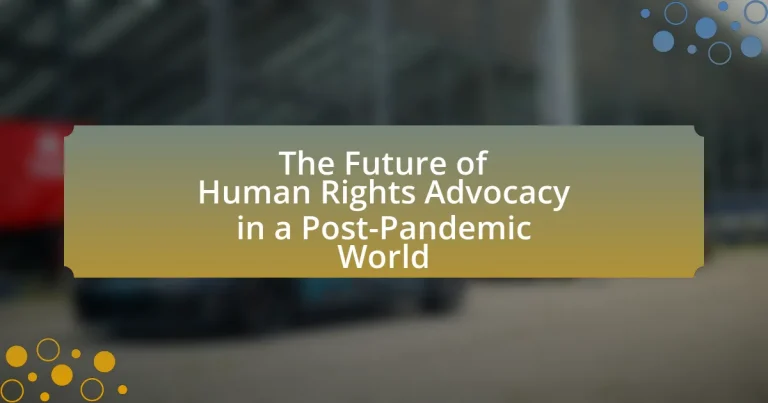The article examines the future of human rights advocacy in a post-pandemic world, emphasizing the shift towards digital activism and the importance of intersectionality. It highlights how the COVID-19 pandemic has exacerbated existing inequalities and restricted civil liberties, prompting advocates to adapt their strategies to address issues such as racial justice, gender equality, and economic disparity. Key challenges include the rise of authoritarianism and misinformation, while opportunities for advocacy are presented through increased digital engagement and global solidarity movements. The article also discusses the role of technology in enhancing advocacy efforts and the need for collaboration among organizations to effectively address complex human rights issues moving forward.

What is the Future of Human Rights Advocacy in a Post-Pandemic World?
The future of human rights advocacy in a post-pandemic world will increasingly focus on digital activism and intersectionality. The COVID-19 pandemic has accelerated the use of technology for mobilization, allowing advocates to reach broader audiences through social media and online platforms. For instance, the rise of virtual events and campaigns has enabled organizations to maintain engagement despite physical distancing measures. Additionally, the pandemic has highlighted systemic inequalities, prompting advocates to address issues such as racial justice, gender equality, and economic disparity more holistically. Reports from organizations like Human Rights Watch indicate that the pandemic has exacerbated existing human rights violations, necessitating a more integrated approach to advocacy that considers multiple dimensions of identity and experience.
How has the COVID-19 pandemic impacted human rights advocacy?
The COVID-19 pandemic has significantly impacted human rights advocacy by exacerbating existing inequalities and restricting civil liberties. During the pandemic, many governments implemented emergency measures that limited freedom of assembly, expression, and movement, often disproportionately affecting marginalized communities. For instance, reports from organizations like Human Rights Watch and Amnesty International documented increased police violence and discrimination against vulnerable groups, including racial minorities and the homeless. Additionally, the pandemic shifted advocacy efforts online, leading to a greater reliance on digital platforms for mobilization and awareness, which also raised concerns about digital privacy and surveillance. These changes highlight the urgent need for human rights advocates to adapt their strategies in response to both the immediate challenges posed by the pandemic and the long-term implications for civil liberties.
What specific human rights issues have emerged during the pandemic?
During the pandemic, specific human rights issues that emerged include increased discrimination, restrictions on freedom of movement, and violations of privacy rights. Discrimination against marginalized groups, such as racial minorities and refugees, intensified as access to healthcare and social services became limited. Restrictions on freedom of movement were implemented through lockdowns and travel bans, often disproportionately affecting low-income individuals and those without stable housing. Additionally, privacy rights were compromised due to the widespread use of surveillance technologies aimed at tracking virus spread, raising concerns about data protection and civil liberties. These issues highlight the need for robust human rights advocacy in the post-pandemic world.
How have advocacy strategies changed in response to the pandemic?
Advocacy strategies have shifted significantly in response to the pandemic by increasingly utilizing digital platforms for outreach and engagement. Organizations have adapted to remote communication methods, leveraging social media, webinars, and virtual events to mobilize support and raise awareness about human rights issues. For instance, the use of online petitions and digital campaigns surged, with platforms like Change.org reporting a 50% increase in petitions related to social justice during 2020. This transition to digital advocacy has allowed for broader participation and engagement, reaching diverse audiences who may not have been accessible through traditional methods.
What are the key challenges facing human rights advocacy today?
Key challenges facing human rights advocacy today include the rise of authoritarianism, the impact of misinformation, and the effects of the COVID-19 pandemic. Authoritarian regimes have increasingly suppressed dissent and curtailed freedoms, as seen in countries like Belarus and Myanmar, where protests have been met with violent crackdowns. Misinformation, particularly on social media, undermines public trust in human rights organizations and distorts narratives, complicating advocacy efforts. Additionally, the pandemic has exacerbated inequalities, with marginalized communities facing heightened risks and reduced access to resources, as reported by the United Nations in their 2021 Human Rights Report. These factors collectively hinder the effectiveness of human rights advocacy in addressing urgent global issues.
How do economic factors influence human rights advocacy efforts?
Economic factors significantly influence human rights advocacy efforts by determining the availability of resources, funding, and public support for initiatives. For instance, during economic downturns, governments may prioritize budget cuts that affect human rights programs, leading to reduced advocacy capacity. Additionally, economic inequality can exacerbate human rights violations, prompting advocacy groups to focus on marginalized communities. Research by the World Bank indicates that countries with higher income inequality often experience increased social unrest, which can drive human rights advocacy efforts to address systemic injustices. Thus, the economic landscape directly shapes the strategies and effectiveness of human rights advocacy.
What role does technology play in overcoming advocacy challenges?
Technology plays a crucial role in overcoming advocacy challenges by enhancing communication, mobilization, and data collection. Digital platforms enable advocates to reach wider audiences quickly, facilitating grassroots movements and raising awareness on human rights issues. For instance, social media campaigns have successfully mobilized support for various causes, evidenced by the #MeToo movement, which gained global traction through online platforms. Additionally, technology allows for efficient data gathering and analysis, helping organizations to track human rights violations and present evidence effectively to policymakers and the public. This integration of technology not only amplifies voices but also strengthens the overall impact of advocacy efforts in a rapidly changing world.
What opportunities exist for human rights advocacy in the post-pandemic era?
Opportunities for human rights advocacy in the post-pandemic era include increased digital engagement, heightened awareness of social inequalities, and the potential for global solidarity movements. The pandemic has accelerated the use of technology, allowing advocates to reach wider audiences through online platforms, which can facilitate campaigns and mobilize support more effectively. Additionally, the crisis has exposed systemic injustices, prompting a greater public discourse on issues such as healthcare access, economic disparity, and racial inequality, thus creating a fertile ground for advocacy efforts. Reports from organizations like Human Rights Watch indicate that the pandemic has galvanized grassroots movements, leading to a resurgence in activism focused on human rights protections and reforms.
How can collaboration between organizations enhance advocacy efforts?
Collaboration between organizations enhances advocacy efforts by pooling resources, expertise, and networks to create a more unified and powerful voice. When organizations collaborate, they can share best practices, leverage each other’s strengths, and reach broader audiences, which increases the impact of their advocacy campaigns. For instance, a study by the Stanford Social Innovation Review found that collaborative advocacy efforts can lead to a 30% increase in policy influence compared to isolated initiatives. This synergy not only amplifies messaging but also fosters innovation in strategies, making advocacy more effective in addressing complex human rights issues in a post-pandemic world.
What innovative approaches are being adopted in human rights advocacy?
Innovative approaches in human rights advocacy include the use of technology, such as digital platforms for awareness campaigns and data collection, which enhance outreach and engagement. For instance, organizations are leveraging social media to mobilize support and disseminate information rapidly, reaching wider audiences than traditional methods. Additionally, the integration of artificial intelligence in monitoring human rights abuses allows for more efficient data analysis and reporting, enabling advocates to respond swiftly to violations. These methods have been validated by the increased effectiveness of campaigns during recent global movements, demonstrating a shift towards more adaptive and responsive advocacy strategies in a post-pandemic context.
How can we transition from pandemic responses to sustainable advocacy practices?
To transition from pandemic responses to sustainable advocacy practices, organizations must integrate lessons learned during the pandemic into long-term strategies. This involves adopting flexible frameworks that prioritize community engagement and utilize digital tools for outreach and education, as evidenced by the increased use of virtual platforms during the pandemic which expanded access to advocacy efforts. Furthermore, establishing partnerships with local stakeholders can enhance the sustainability of advocacy initiatives, as collaboration has proven effective in mobilizing resources and support during crisis situations.
What specific strategies can be implemented for effective advocacy moving forward?
Effective advocacy moving forward can be achieved through the integration of digital platforms, grassroots mobilization, and strategic partnerships. Digital platforms enable organizations to reach wider audiences and engage supporters through social media campaigns, online petitions, and virtual events, which have proven effective during the pandemic. Grassroots mobilization fosters community involvement, empowering individuals to advocate for their rights and influence local policies. Strategic partnerships with other organizations, including NGOs, governmental bodies, and private sectors, enhance resource sharing and amplify advocacy efforts. For instance, the collaboration between Amnesty International and local groups has historically increased visibility and impact in human rights campaigns.
How can grassroots movements be empowered in the post-pandemic context?
Grassroots movements can be empowered in the post-pandemic context by enhancing digital engagement and fostering community collaboration. The shift to online platforms during the pandemic has demonstrated the effectiveness of digital tools in mobilizing support and disseminating information. For instance, social media campaigns have successfully raised awareness and funds for various causes, as seen in movements like Black Lives Matter, which gained significant traction through online activism. Additionally, local organizations can strengthen their networks by partnering with other community groups, leveraging shared resources, and creating coalitions that amplify their voices. Research indicates that collaborative efforts can lead to more impactful advocacy, as evidenced by the success of joint initiatives in addressing social issues during the pandemic.
What role do international organizations play in shaping future advocacy?
International organizations play a crucial role in shaping future advocacy by establishing global norms, facilitating dialogue, and mobilizing resources for human rights initiatives. These organizations, such as the United Nations and Amnesty International, provide platforms for collaboration among states, civil society, and other stakeholders, which enhances the effectiveness of advocacy efforts. For instance, the UN’s Universal Declaration of Human Rights serves as a foundational document that guides advocacy strategies worldwide. Additionally, international organizations often conduct research and publish reports that highlight human rights violations, thereby raising awareness and prompting action. Their ability to influence policy at both national and international levels is evidenced by the adoption of treaties and conventions that reflect their advocacy efforts, such as the Convention on the Rights of the Child, which has been ratified by 196 countries, demonstrating widespread commitment to advancing children’s rights globally.
What best practices should advocates adopt in a post-pandemic world?
Advocates should adopt a hybrid approach that combines digital engagement with traditional advocacy methods in a post-pandemic world. This practice allows for broader outreach and inclusivity, as evidenced by the significant increase in online activism during the pandemic, which saw a 50% rise in social media engagement for human rights issues. Additionally, advocates should prioritize mental health and well-being, recognizing the psychological toll of the pandemic on communities, which can enhance the effectiveness of their advocacy efforts. Implementing data-driven strategies to assess community needs and leveraging technology for virtual events can further strengthen their impact.


